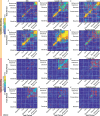Encoding of visual stimuli and behavioral goals in distinct anatomical areas of monkey ventrolateral prefrontal cortex
- PMID: 40773509
- PMCID: PMC12342307
- DOI: 10.1371/journal.pbio.3003041
Encoding of visual stimuli and behavioral goals in distinct anatomical areas of monkey ventrolateral prefrontal cortex
Abstract
The lateral prefrontal cortex has been classically defined as an associative region involved in the so-called executive functions, such as guiding behavior based on abstract rules and mnemonic information. However, most neurophysiological studies on monkeys did not address the issue of whether distinct anatomical sectors of lateral prefrontal cortex play different functional roles. The main aim of this work is to study functional properties of neurons recorded from a large part of ventrolateral prefrontal cortex (VLPF) of two monkeys performing passive visual tasks and a visuo-motor task, and to map them on the anatomical areas defined on the basis of our recent parcellations. Our results show that some functional features are broadly distributed within VLPF, while others characterize specific areas. In particular, the temporal structuring of events and the general behavioral rule appear to be coded in all recorded areas, while each area differently contributes to the encoding of visual features and to the exploitation of contextual information for guiding behavior. Caudal VLPF areas, and especially caudal 12r, are characterized by a strong coding of visual information, both when passively presented or exploited for guiding behavior, while middle VLPF areas, and especially middle 46v, are rather more involved in the processing of contextual information for action organization. In this latter sector, visual stimuli/instructions appear to be encoded in a pragmatic format, that is, in terms of the associated behavioral outcome. Finally, area 45A and more anterior VLPF areas are characterized by a generally lower responsiveness to the employed tasks. Altogether, our findings indicate that caudal VLPF areas represent the first processing stage of visual input while middle VLPF areas primarily contribute to the selection and planning of contextually appropriate behaviors.
Copyright: © 2025 Basile et al. This is an open access article distributed under the terms of the Creative Commons Attribution License, which permits unrestricted use, distribution, and reproduction in any medium, provided the original author and source are credited.
Conflict of interest statement
The authors have declared that no competing interests exist.
Figures










References
-
- The prefrontal cortex. Elsevier. 2015. doi: 10.1016/c2012-0-06164-9 - DOI
MeSH terms
LinkOut - more resources
Full Text Sources

